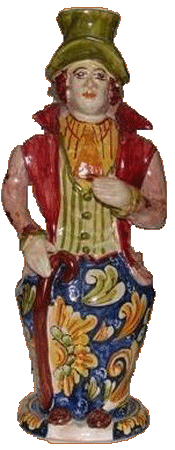Le lucerne antropomorfe nella maiolica calatina
The oil lamps in the anthropomorphic majolica calatina
Until the oil constituted the main fuel to light houses, the oil lamps were common and essential household objects: made from bronze or copper, hold on a high foot in exclusive houses, from ceramic or often made from clay in poor houses. In the countryside, despite the appearance of the kerosene lamp the use of oil lamps lasted for a long time, coming to an end only with the advent of electricity.
The most popular style of earthenware oil lamps was the small circular tank with spout edge . the first adjustment of the tank took place in the Middle Ages, where a high sustain was placed on it and even if it was turned made, enable to keep blaze up and at the same time, it was easier to hold and carry it anywhere. This system or framework lasted unchanged in time, mostly in the western factories of Sicily, like Palermo, Sciacca and Trapani.
A different style had the majolica lamps in the eastern Sicily of sixteenth century, especially in Caltagirone. Where plastic decoration, going by the old Sicilian tradition, added to throwing decoration and enhancement. It came out the anthropomorphic lamps.
The Oil lamp statue (The oil lamp figurine) came out from the medieval lamps processing, raised on a high foot and with a hint of eyes painted on the return of the tub spout. And thanks to the talent of various potters that enhanced with plastic decoration an elegant statue of a woman (feminine figurines) therefore, made the changeover possible to the elegant environment of ceramic lamps.
During The sixteenth-century the majolica Lamps( the oil lamp figurines) completely represented by noble women in matron poses, with one arm at her hip and the other on her belt, luxuriously decorated with necklaces and diadems: in their bodies was soaked a long wick that comes out on the back side of the frontal crown . nevertheless, were not exempt from downside: it was so heavy to shift it, required a huge quantity of oil if need to use more than one lamp. it was difficult to fuel it from the same narrow hole where the wick pass through.
In the eighteenth century the oil lamps figurines undergoes some changes that made shift more easier and cheaper use use. instead of the heavy and large oil tank a small tank into the head of the oil lamp figurine, empty and bottomless pit, where the rim raised on the externally base, for the overflowing oil . Moreover the catalogue increased with lots of figure: besides the lady richly dressed, there are gentlemen wearing a top hat, monks, priests, highwaymen (brigand), policemen, also historical character and ordinary people.
The use of these lamps with various subjects launched soon in all over island, replacing completely the metallic lamps, that in comparison was more expensive, humdrum colour and badly decorated.
The Flourishing production of oil lamps was in the nineteenth century, where performed by Giacomo Failla, a great crockery, inexhaustible maker of several kinds of characteristic figures, where all his product was requested in all eastern Sicily markets.
Today it’s so hard to find out the full range of lamps subjects of the shape lamps of Caltagirones craft.






